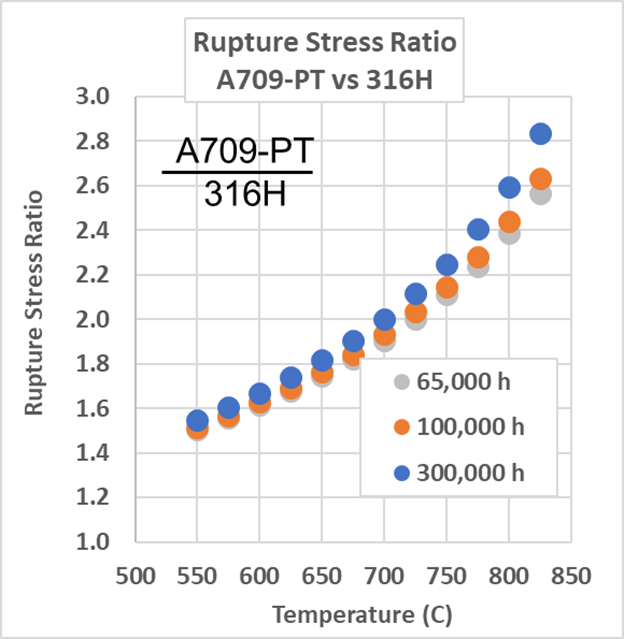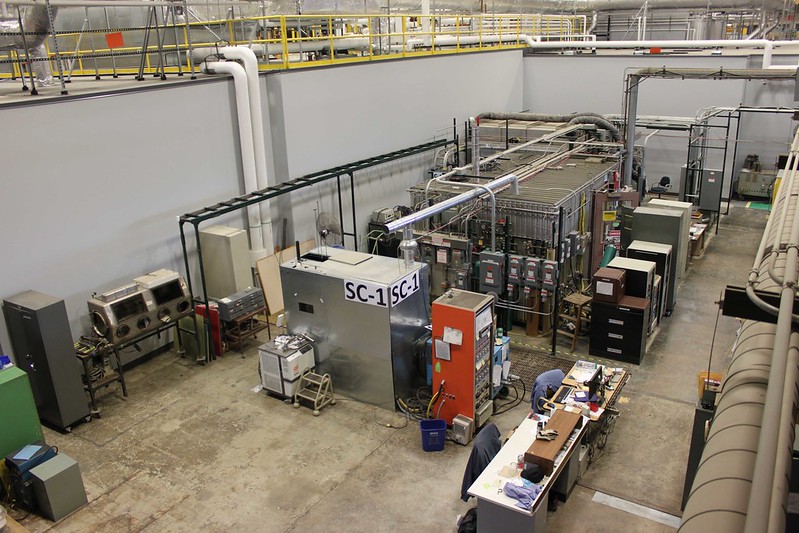Plates from the first commercial heat from G.O. Carlson
Background
Nuclear power contributes significantly to meeting the nation’s energy, economic, environmental, and national security needs. Sodium Fast Reactor (SFR) is a leading candidate for recycling used fuel to close the fuel cycle and for power generation. While the SFR technology is relatively mature, there must be improvements in the capital cost and economic return before the private sector will invest in the large-scale, commercial deployment of SFRs. Further, greater safety margins and increased flexibility will also be required of any new advanced reactor systems. Flexibility, safety, and economics were all identified as the key needs for advanced reactors.
Innovative designs and design simplifications could be made possible using materials with enhanced mechanical properties. Improved materials performance also impacts safety through improved reliability and greater design margins. Improved material reliability could also result in reduced down time.
Advanced Materials
The advanced materials technical area of the Fast Reactor Program is to provide the technical basis needed to support the regulatory requirements for structural materials required for fast reactors that could be deployed in the near-to-mid-term by the U.S. nuclear industry. Structural materials differ from cladding and other materials close to the fuel in that they are farther from the reactor core and have less exposure to the neutron flux.
There are currently only six ASME qualified construction materials (304H, 316H, Alloy 800H, 2.25Cr-1Mo, 9Cr-1Mo-V, and Alloy 617) for advanced high temperature reactor applications. With the exception of Alloy 617, these materials were introduced to the ASME Code very long time ago, where the last material, before Alloy 617, was incorporated in the early 2000’s. These “older” Code materials do not reflect the superior physical properties and resilience possible with modern materials. The introduction of advanced materials having enhanced mechanical properties into the ASME code will allow designers to remove constraints imposed by the current code qualified materials and to improve the performance, cost, and safety of future designs.
Completion of the Alloy 709 Code Case will allow U.S. reactor vendors to decrease the capital cost, expand the design envelope, and increase the safety margin in the deployment of sodium fast reactors and other reactor concepts such as MSR and FHR. This will boost the competitiveness of the U.S. advanced reactors sector, create high-paying jobs, and increase economic growth.
The current focus of the Advanced Materials technical area is to qualify an additional higher performing structural material, the Alloy 709 advanced stainless steel, to enable its use by SFR developers to expand the fast reactors design envelope.
Background on Code Qualification of Alloy 709
Alloy 709 is an advanced austenitic stainless steel. A materials down-selection for fast reactor applications was conducted and Alloy 709 was recommended for ASME Section III, Division 5 code qualification due to its significant enhancement in mechanical properties relative to 316H stainless steel, which is a reference construction material for SFR systems. A comprehensive plan was established to qualify Alloy 709 for Division 5 Class A construction. A “staged” code qualification approach was developed to generate data in support of successive code cases with progressively longer design lifetimes. The Phase I implementation of this plan includes the development of data package for a 760C and 100,000-hour Division 5 code case, and the initiation of very long-term creep tests and thermal aging tests to support the extension of the 100,100-hour design life to longer times when data are available. To support the use of Alloy 709 in sodium service, sodium compatibility tests were also initiated.
Phase I
To execute the Phase I plan, creep testing equipment was stood up at Argonne National Laboratory, Idaho National Laboratory and Oak Ridge National Laboratory through upgrades and refurbishment of existing equipment and procurement of new equipment to support the generation of creep rupture data for the Alloy 709 code case. In collaboration with material vendor G.O. Carlson Inc. of Pennsylvania, the program successfully scaled the production of Alloy 709 from a laboratory heat of approximately 500 pounds to a commercial heat of 45,000 pounds. Hot-rolled plates were fabricated from the first commercial heat to support testing. ASME requires code case data package to be developed from a minimum of three commercial heats. The second and third commercial heats of 40,000 and 38,000 pounds respectively were procured from ATI, Inc., PA and the hot-rolled plates were fabricated from these heats.
Plates from the second commercial heat from ATI
Plates from the third commercial heat from ATI
The NEI-based Fast Reactor Working Group (FRWG) has identified the need for enhanced material testing to support near-term material insertions and nth-of-a-kind long plant life concepts. The Alloy 709 work supports this mission by qualifying a leading advanced material for future fast reactor applications. In addition, Alloy 709 has also drawn interest for structural applications in molten salt reactor, fluoride salt-cooled high temperature reactor and gas-cooled reactor because of its enhanced mechanical properties over 316H stainless steel.
Extrapolation of initial test data from the commercial heats show that the creep rupture resistance of Alloy 709 is indeed superior to 316H stainless steel.
The Alloy 709 code qualification effort is ongoing and is being perfomed collaboratively at Argonne, Idaho National Laboratory and Oak Ridge National Laboratory .
Alloy 709 sodium compatibility testing is being conducted at Argonne to support use of Alloy 709 in sodium service.
Completion of the Alloy 709 Code Cases will allow U.S. reactor vendors to develop designs that would decrease the capital cost, expand the design envelope, and increase the safety margin in the deployment of SFRs and other advanced reactor concepts.

